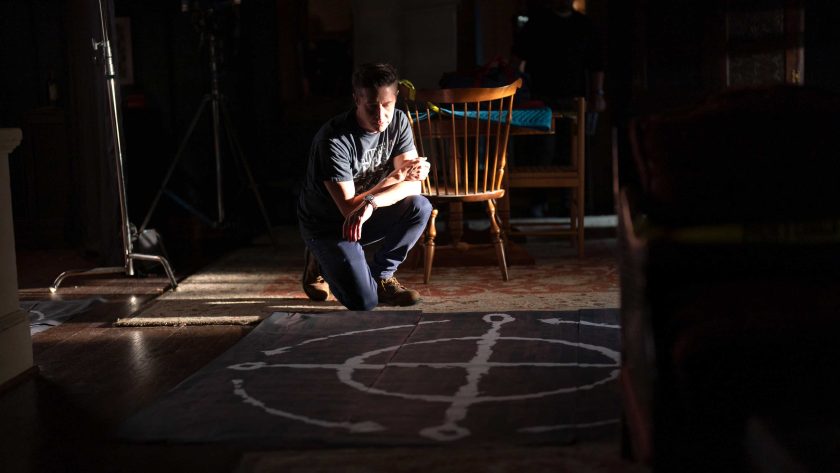Oscar Lyons reviews the anticipated sequel ‘The Exorcist: Believer’, in an unsuccessful attempt to fix his post-Halloween blues.
Any comedown is sure to provide solid grounds for soul-searching and angst. So it should have come as little surprise that, on a recent visit to my local multiplex, I was struck down by post-Halloween blues. For while ‘The Exorcist: Believer’ once promised something, it crushingly amounted to very little. Hunched over in my seat to the fast-fading strains of a revamped ‘Tubular Bells’, hands faithfully bound together, my mind couldn’t help but think ahead to the lonely walk that lay ahead.
Some traditions never tire. In the wake of a spectacularly damp and gloomy Halloween season, your faithful correspondent can confirm that the ongoing craze for RE-makes/-boots/-quels continues to gather momentum. Or, if not quite momentum, then at least sustained life. In recent times we have been treated to several updated contributions to the Horror Pantheon. Crucially, these have borne varying levels of quality, from the delightful [‘Evil Dead Rise’] to the perplexing [‘Halloween’] and finally to the interminably frustrating [‘Scream’]. United in each of these efforts is the near-casual recognition on the part of each production studio that what sells is what is known. And while the genre of horror has often been a hotbed of innovation and fresh inspiration, there is an acknowledgement among leading production companies that in the post-pandemic, post-streaming entertainment landscape, there is a need for pragmatic decision-making. Thus, ‘Believer’ arrived on reasonably solid footing.
For one, it is yet another product of Blumhouse Productions. What started out as an outsider capitalising on exploitative, What If? plotlines with low-key fare such as ‘Paranormal Activity’ and ‘The Purge’ is now an industry mainstay. Witness it’s newer, glossier credit sequence as proof of its assured heft. More intriguing is that it marks the second storied horror franchise that longtime collaborators David Gordon Green and Danny McBride have chosen to revive. There is an urgency to this work, too, given ‘Believer’ hit cinemas to mark the one-year anniversary of ‘Halloween Ends’. The final feature in their trilogy, however, left viewers with a sour aftertaste. Regardless of my own appreciation for their work, what emerged as an enterprising take on a fast-dwindling franchise was soon faced with ever-diminishing commercial and critical success. Could ‘Believer’ reverse course and recapture the vitality of 2018’s ‘Halloween’? Or would it only add more grist to the fire of horror-faithful critics wary of interlopers? Either way, it came to theatres burdened by the weight of two titans of the wider genre.
The movie focuses predominately on a father-daughter relationship. Victor and Angela Fielding are new characters introduced to a pre-existing Exorcist universe some fifty years on from the traumatic events of the original. While the film’s opening presents one moral quandary I am distinctly under-qualified to offer succinct, insightful commentary on, it does end in dramatic consequences. Needless to say, Victor emerges from an idyllic vacation to Haiti a widowed father entering unknown territory. From here, the stamp of the original is promisingly born. This can be detected in the delightful sound design, which captures the jarring tones of a child’s fingers moistly dragging over glass and the sharp prodding of a branch on a bedroom window one windy night. Notably throwbacks to the original include a soiling scene that fully embraces the value in the decision to gender-swapping the beleaguered parent. This is compelling stuff, even more so when Green treats us to a moment of real ingenuity. Breaking free of the constraints of imitation, Green unleashes visions of real horror during an initially benign family photoshoot. Unfortunately, this boldness proves satisfying in a way few other moments do.
The unbearable weight of superfluous characters is a problem this film is fatally unable to overcome. 1973’s original bore a solid roster of tightly controlled characters. By now, the following are near-household names: Chris MacNeill, Father Karras, Merrin, and, of course, Regan. In stark contrast, you would be hard-pressed to cohere both Bin Lady and Boxing Man into the climactic final act. Rather, the Fielding’s are forced to entertain a roster of characters who are at once caricatures of distinct, incurably surface-level personalities that fade fast into the wallpaper the minute they are off-camera. This decision, one can presume, is informed by the open-secret that Blumhouse (and others) have green-lit a trilogy of movies. While this encourages a certain sense of stability, it also means that this first entry feels less of a movie than what it actually is: a roadmap of the vast array of characters who will surely sustain the following two entries. This is problematic. For starters, the shame fate befell ‘Ends’. Create enough characters who are superfluous to the story and pretty soon the actual story becomes superfluous too. By the time said showdown occurs, I was still grappling with the hows rather than the whys. Failing that, should the audience care when, in a desperate Hail Mary attempt to inject weight into an otherwise ambling storyline, we are informed that every life is indeed at stake? Unfortunately, this culminates in a climactic sequence that bears greater resemblance to a slapstick version of ‘Avengers: Assemble’ than anything truly horrific.
This is arguably both a limitation of the source material and in turn a failure on the part of its creator to truly grapple with what it is they are working towards. The original bore the hallmarks of a coherent storytelling team: It was both written and adapted for the screen by William Peter Blatty, who in turn chose director William Friedkin to carefully craft the source material for the screen. Unfavourable comparisons can also be drawn with their other contribution to the horror canon. While Green/McBride had the comfortably defined villain of Michael Myers for inspiration with ‘Halloween’, here they are left murkily figuring out what exactly evil spirit Pazuzu stands for in the twenty-first century. Meanwhile, the relative uninvolvement of the returning Ellen Burnstein stands in stark contrast with the central importance of Jamie Lee Curtis throughout the ‘Halloween’ trilogy. This culminates in a new entry that starts off by displeasing loyal fans then proceeds to disappoint newly arrived viewers.
‘Believer’ bears the hallmarks of a movie utterly unsure of itself. In a moment of startling clarity, a character enquires bluntly ‘What do you think evil is?’ To which they instantly embark upon a horrendously ham-fisted, surface-level thesis on human hope, all the while set against a backdrop of various characters as they slowly hug, kiss, and embrace one another in well-paced montage. This stands for more than a mere failure to respect the original; it is a failure to craft a coherent story.




